Frogs are amphibians with webbed toes, large, protruding eyes, moist skin, and a somewhat bent body. They are equipped with long legs and soft, wet skin, distinguishing them from toads. Some can leap up to 20 times their body length thanks to their long legs. In Texas, they say, everything is bigger! That is also true for the Lone Star State’s diverse array of plants and animals.
In Texas, there are roughly 44 different species of frogs that live in a variety of habitats. It is the ideal environment for many amphibians that live on land and in water due to its diverse ecosystem. However, some species populations have been dropping, while others risk habitat loss and extinction due to contamination. Below, we will look at 15 of Texas’s most common frog species!
15 Types of Frogs in Texas
1. American Bullfrog
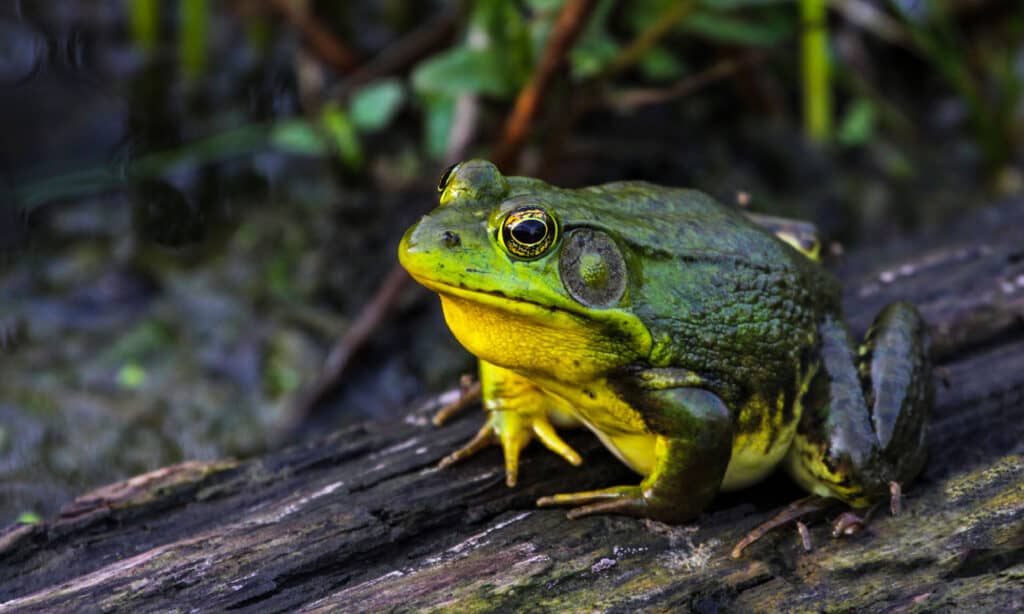
American bullfrogs are the largest frogs in North America.
©iStock.com/187715314
They are the biggest frogs that naturally occur in North America and can be found in Canada and the United States. Bullfrogs can now be found throughout South America as a result of their migration due to human activity. The largest frog species in America, the American bullfrog has a white venter and dark green skin. Bullfrogs can be found in lakes, ponds, marshes, and other permanent water bodies. The male frogs choose egg locations in shallow waters during the breeding season, which they fiercely protect.
2. Rio Grande Leopard Frog

The Rio Grande
Leopard
Frog are common in ponds, rivers, savannas, and grasslands.
©iStock.com/Kevin Wells
Texas is home to the Rio Grande Leopard Frog, an aquatic frog that inhabits permanent bodies of water and is widespread throughout the state’s central, western, and southern regions. In Texas, Rio Grande Leopard Frogs are common in ponds, rivers, savannas, and grasslands, but they are never found far from water. They have long legs and a variety of pale green, tan, and brown patches on their back, making them look similar to other species of leopard frogs. They hide under rocks and other debris during cold weather.
3. Cajun Chorus Frog
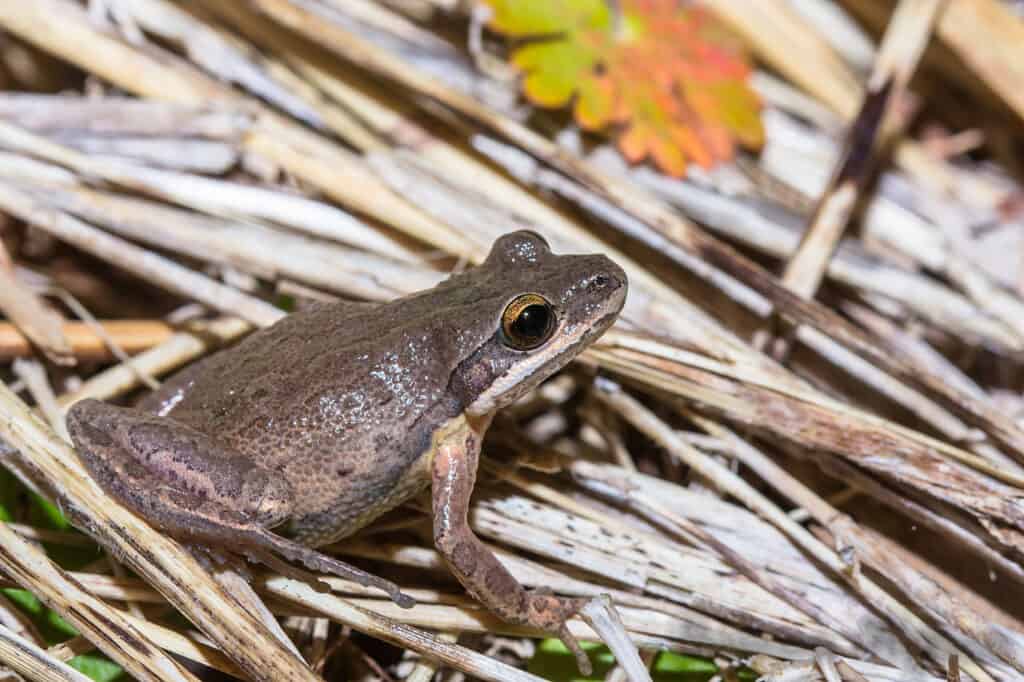
The Cajun chorus frog is widespread throughout southern America.
©Jeromi Hefner / CC BY 2.0 – License
Texas’s plains and grasslands are home to the tiny Cajun chorus frog species. The Cajun chorus frog, which is light brown with three dark brown stripes or spots across its back, is widespread throughout southern America. They will linger along the borders of bodies of water and make a high call that mimics the sound of a pulled comb. Their neck swells up when they call, which normally occurs at a rate of 20 calls per minute. The Cajun chorus frog consumes flies, beetles, and ants to survive.
4. Balcones Barking Frog

Balcones barking frog has a wide head, short hind legs, and a toad-like appearance.
©William L. Farr / CC BY-SA 4.0 – License
Western and central Texas is home to the Balcones barking frog, sometimes known as the eastern barking frog, a subspecies of the common barking frog. It has a wide head, short hind legs, and a toad-like appearance. A male Balcones barking frog’s mating call can sound like a dog from a distance, but it sounds more like a guttural, low-humming murmur up close.
5. Rio Grande Chirping Frog
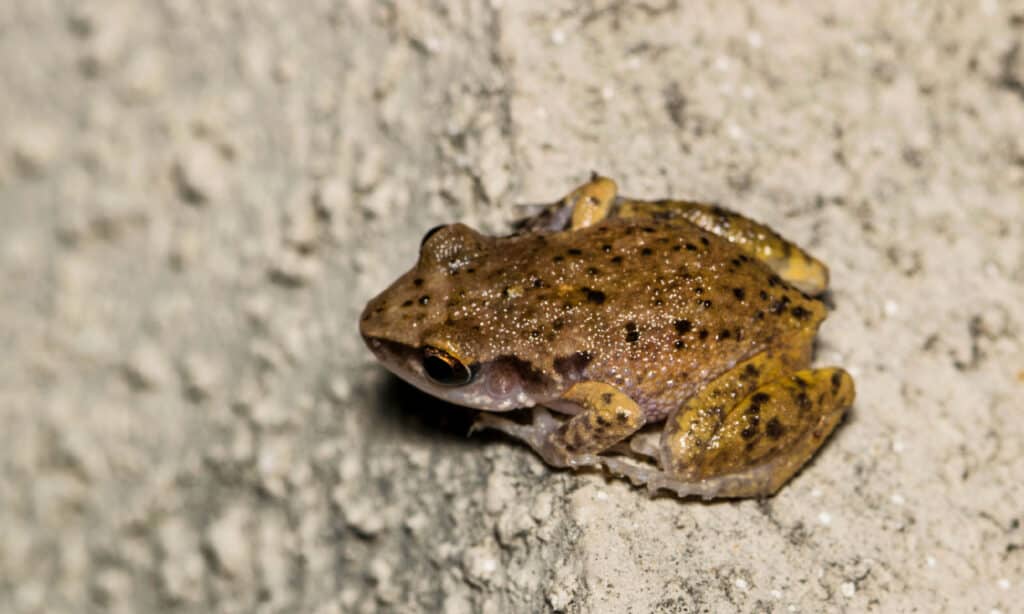
The Rio Grande Chirping Frog has the unusual ability to flee from predators by running rather than leaping.
©iStock.com/Brett_Hondow
Sporadic populations of the Rio Grande chirping frogs are found along the Gulf Coast in southeast Texas. The diminutive size of this frog is well known. The Rio Grande Chirping Frog also has the unusual ability to flee from predators by running rather than leaping. They have a nose with a sharp point and smooth brown, gray, or yellow skin. Their high-pitched call sounds like chirping insects.
These nocturnal creatures inhabit semi-tropical regions with lush vegetation, habitats along waterways, and locations close to semi-permanent water sources. Unlike most Texas native frogs, this species has calls that both males and females make during the rainy season.
6. Cliff Chirping Frog
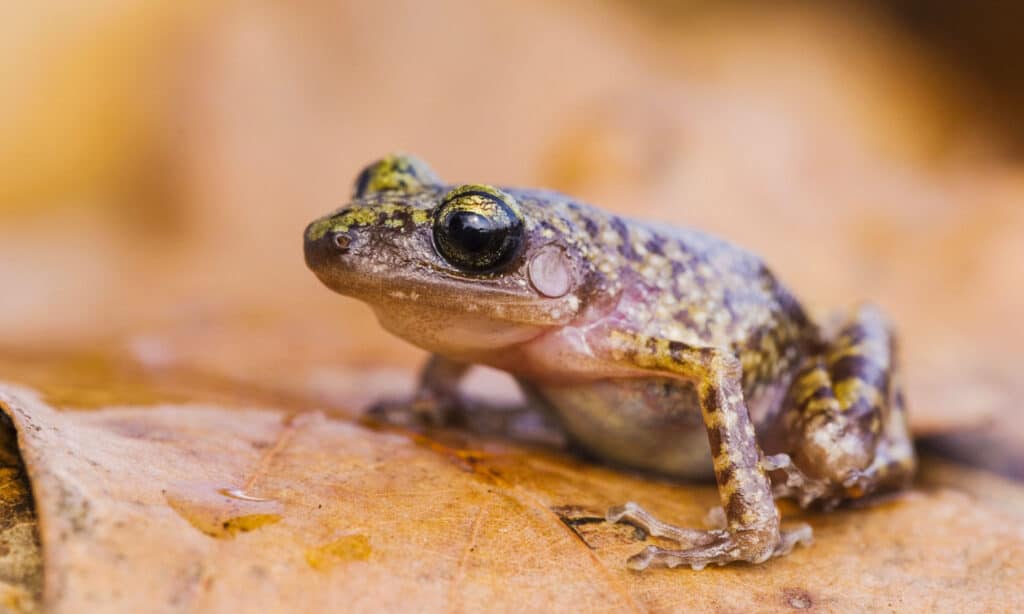
Cliff chirping frogs reproduce on land in areas with moist soil following rainfall.
©Danita Delimont/Shutterstock.com
Limestone-rich rocky locations are home to many cliff chirping frogs. Central and southern Texas is home to them, and they are most active at night. The cliff chirping frog is a smaller type with a flat skull and wider space between its eyes than other frog species. They resemble spotted chirping frogs from the Big Bend region in appearance. Cliff chirping frogs reproduce on land in areas with moist soil following rainfall, in contrast to the majority of the frogs native to Texas.
7. Crawfish Frog

The crawfish frog has dark brown or black circular patterns on its pale green to light gray body.
©Stanley Trauth / CC BY-SA 2.5 – License
Eastern Texas grassland and prairie ecosystems, including meadows and pastures, are home to crawfish frogs. They are busy above ground during the day but don’t wander too far from their hole. The crawfish frog has dark brown or black circular patterns on its pale green to light gray body. They have a small snout and can grow to be huge, measuring 3 inches long. They spend most of the year dwelling in crawfish burrows, hence their name. These frogs breed in fishless waters and feed on spiders and tiny crayfish.
8. Green Frog

Green frogs prefer to be close to constant, accessible food sources because they hunt by waiting and sitting still.
©Paul Reeves Photography/Shutterstock.com
Texas is home to the aquatic species known as the Northern green frog. They are renowned for their striking green hue. However, some green frogs have noticeable bronze coloring and light to dark brown tones. These frogs are among the toughest species and can live in almost any place they have access to a stable body of water. Fish, insects including dragonflies, flies, and larvae, as well as small birds and snakes, are some of their favorite prey. Green frogs prefer to be close to constant, accessible food sources because they hunt by waiting and sitting still.
9. Blanchard’s Cricket Frog
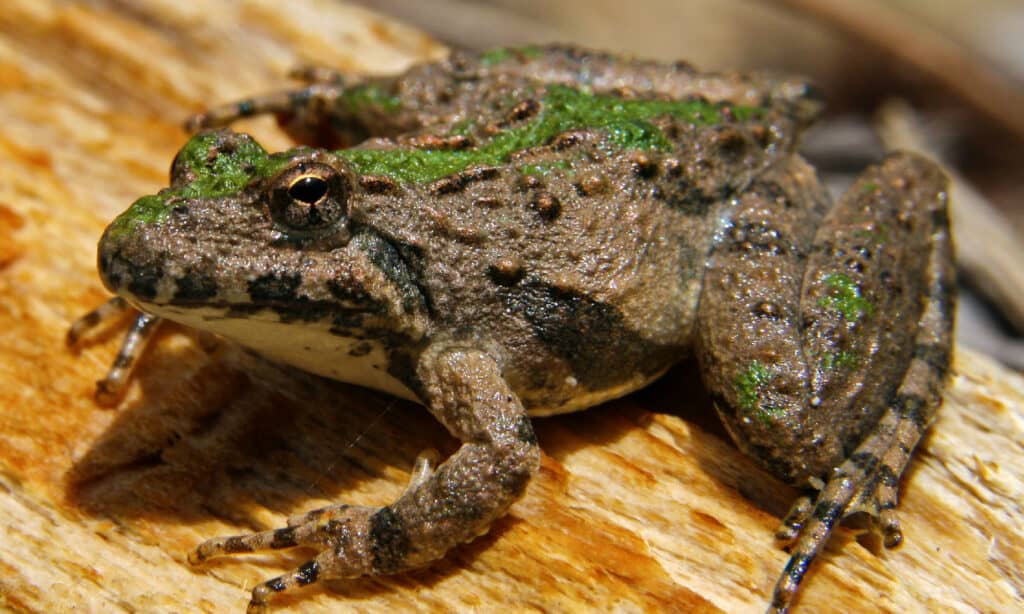
The Blanchard’s cricket frog can be found in or close to lakes, ponds, bogs, and marshes.
©Ryan M. Bolton/Shutterstock.com
The extreme eastern regions of Texas are where you can find the Blanchard’s cricket frog. It can be found in or close to lakes, ponds, bogs, marshes, slow-moving rivers, and streams that are permanent bodies of water in the state. It is active both during the day and at night and is occasionally spotted soaking up the sun. The legs of this species are short and tiny, and they have rough skin colored yellow, red, black, and tan.
10. Greenhouse Frog
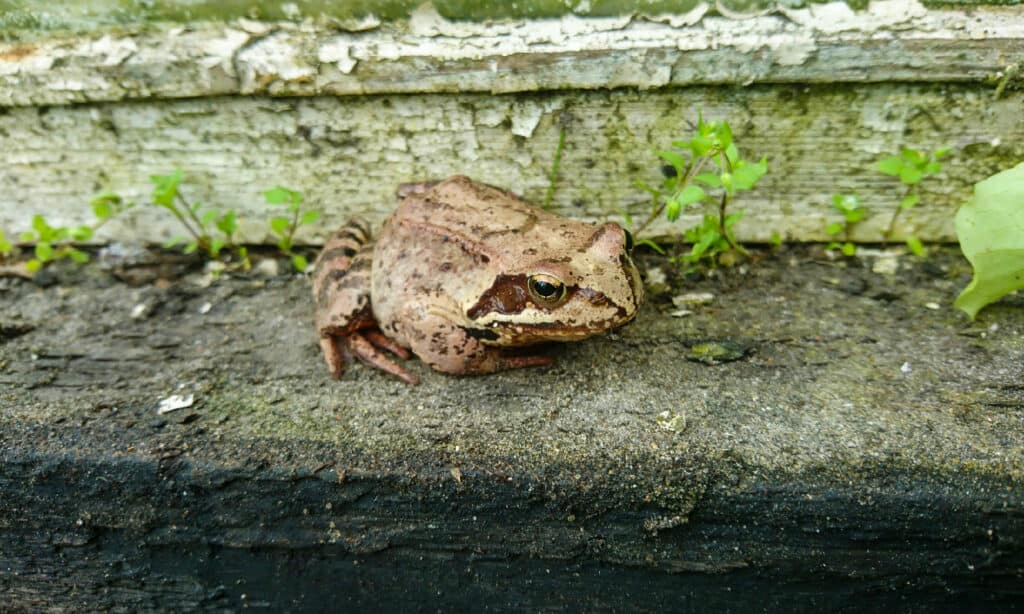
Greenhouse frogs are nocturnal and dwell in the damp leaf litter.
©iStock.com/VirginaGus
A little species known as the greenhouse frog is olive-brown in hue with dark stripes. They have big eyes and a light underside. The Texas Cooperative Wildlife Collection’s voucher specimen from 1999 provided the first evidence of the greenhouse frog in southeast Texas. They are nocturnal and dwell in the damp leaf litter. This species consumes a variety of creatures, including roaches, ants, beetles, and mites. They lay their eggs in damp, dark, protected areas suitable for their eggs instead of in water, unlike other frogs.
11. Pickerel Frog

Pickerel frogs pursue insects like ants and water bugs on land or in the water.
©Andy Choinski/Shutterstock.com
The pickerel frog is poisonous and the only known poisonous frog to live in Texas. It exudes substances from its skin that are harmful to predators but uncomfortable for people. Eastern Texas, meadows, woodlands, and fields—especially those with lush vegetation—are home to the pickerel frog. Its body is brown with dark brown rectangular dots all over it, and the inside surfaces of its hind legs have an orange flash pattern. Pickerel frogs pursue insects like ants and water bugs on land or in the water.
12. White Lipped Frog
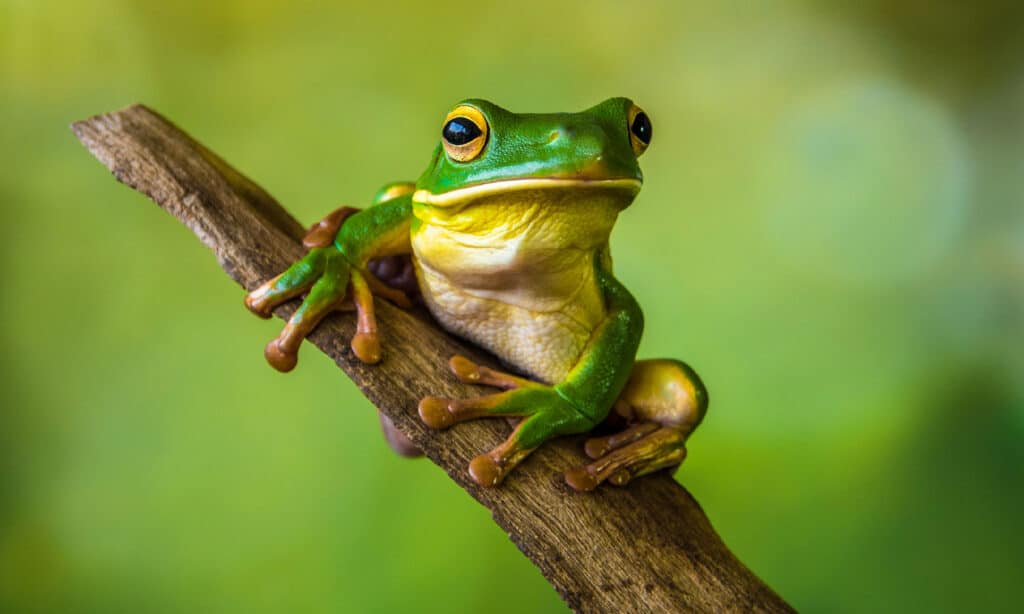
The Mexican white lipped frog is a brown frog with noticeable white stripes along the upper mouth and black and tan markings.
©iStock.com/LESSY SEBASTIAN
The Mexican White Lipped Frog can be found in Mexico, Central America, the Rio Grande Valley of Texas, and Panama. Although it can be found in Southern Texas, this frog is not widespread there and may be one of the least visible in Texas. It is a brown frog with noticeable white stripes along the upper mouth and black and tan markings. This frog can be found in semi-arid, highland tropical forests, grasslands, and savannas.
13. Sheep Frog
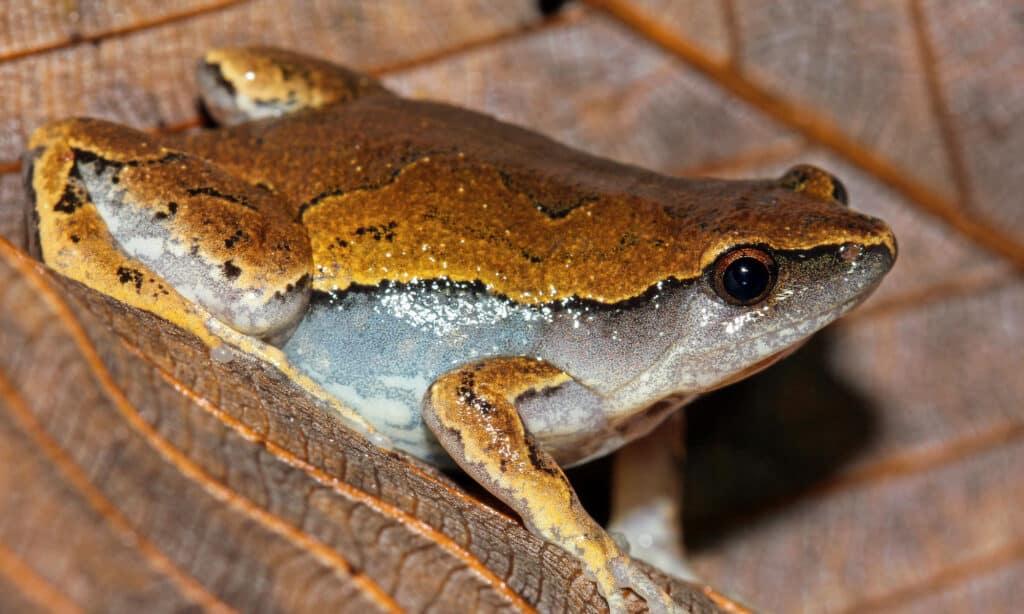
Sheep frogs are classified threatened in Texas.
©Ryan M. Bolton/Shutterstock.com
Currently, 15 counties in Texas, from Aransas and Refugio in the Coastal Bend north to Cameron, Hidalgo, and Starr along the Rio Grande, are known to have sheep frogs. The name “sheep frog” refers to the low, sheep-like sound these frogs make. They dwell in humid environments and tropical forests. Small eyes and two sizable glands that inflate to aid in swimming are both features of these animals. Sadly, they are classified as threatened in Texas.
14. Spring Peeper
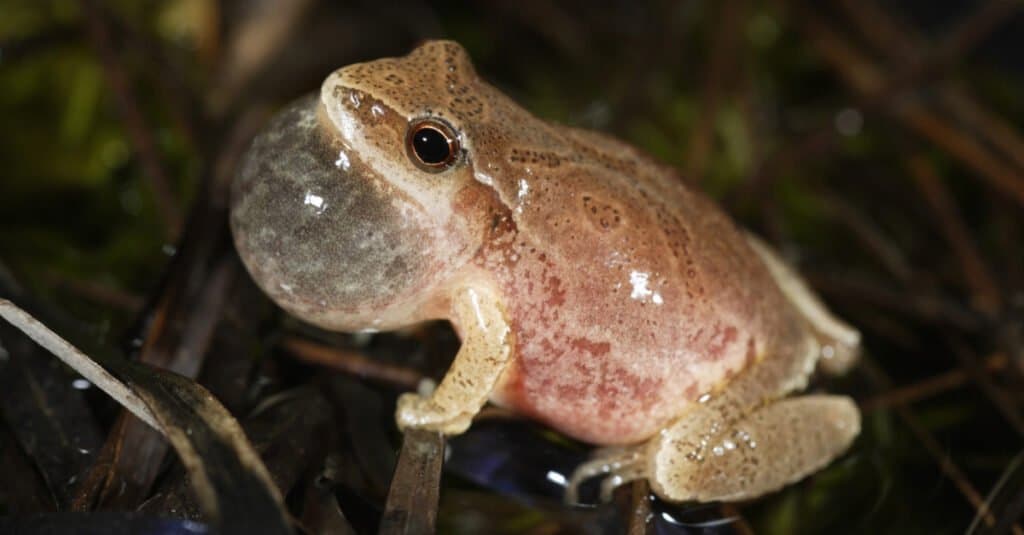
Spring peepers are generally seen on the forest floor amongst leaves.
©Paul Tessier/Shutterstock.com
The spring peeper is a tree frog inhabiting Texas, the United States’ woodlands, and suburban regions. Spring peepers are generally seen on the forest floor amongst leaves. Nevertheless, they have substantial toe pads that they employ when climbing trees. One of the first frogs to begin calling in the spring are these small frogs, which can be found throughout eastern Texas. They breed and lay eggs in marshes, ponds, swamps, and other tiny bodies of water.
15. Pig Frog
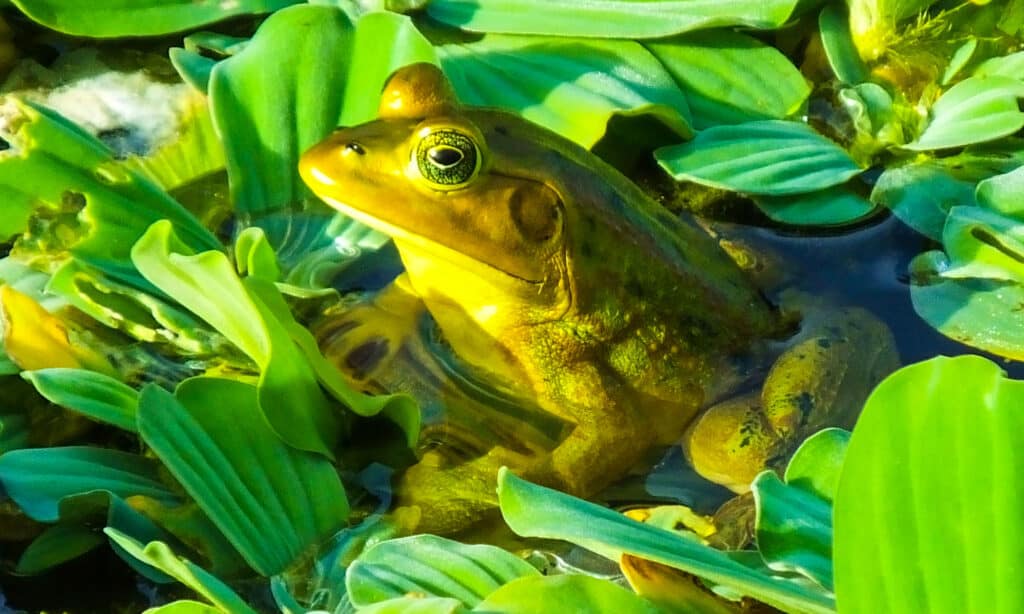
The diet of the pig frog includes crayfish, insects, and other frogs.
©iStock.com/passion4nature
The pig frog, also known as the lagoon frog or southern bullfrog, is an extremely aquatic frog that may be found all over the southern United States, from Texas to South Carolina. They got their name from the summertime sound of their pig-like call. These frogs have black or brown blotches on a green or gray-green background. Their diet consists of crayfish, insects, and other frogs. They primarily engage in activity at night and inhabit bordered environments such as lakes, marshes, and densely vegetated waterways.
Up Next:
Why Do Frogs Croak? Why Do They Ribbit?
Frog Predators: What Eats Frogs?
The photo featured at the top of this post is © Danita Delimont/Shutterstock.com
Sources
- Bird Watching Hq, Available here: https://birdwatchinghq.com/frogs-in-texas/
- Dockline Magazine, Available here: https://docklinemagazine.com/2021/06/frogs-native-to-texas/
Thank you for reading! Have some feedback for us? Contact the AZ Animals editorial team.






